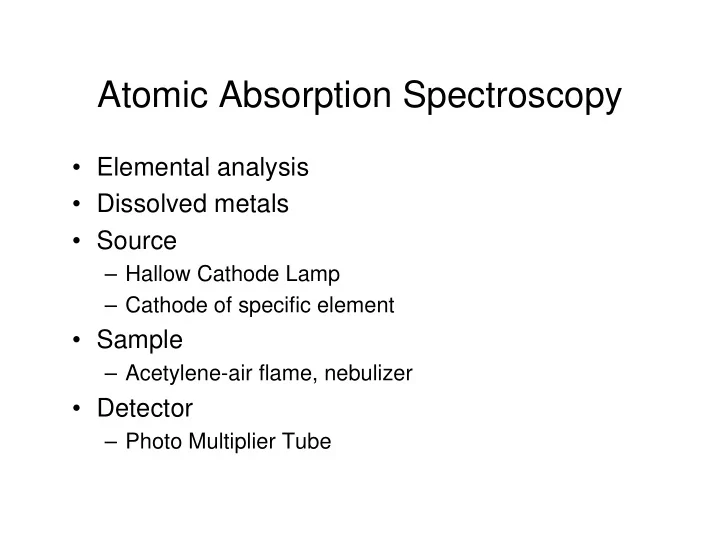

Atomic Absorption Spectroscopy • Elemental analysis • Dissolved metals • Source – Hallow Cathode Lamp – Cathode of specific element • Sample – Acetylene-air flame, nebulizer • Detector – Photo Multiplier Tube
Atomic absorption • Gas-phase elemental atoms • Narrow absorption lines (±0.01 nm) – No solvent – No vibrations and rotations • Element specific source • Flame conditions control sensitivity • 1-100 ppm (mg/L) • varies with element
AA Spectrometer PMT Hollow cathode lamp Flame monochrometer Coating of element Air nebulizer Acetylene sample
Removal of Atomic Emission • Place a chopper before the flame • The signal from the source is modulated by the chopper • Thus, a AC signal is produced on top of a DC signal that originates from emission in the flame
Experiment • Aspirate blank, set 100 % T • Aspirate sample • Matrix Effects are common – Standard addition experiment
Standard Addition Analysis • Add known quantities of standard to your sample and plot abs vs. concentrated added – This way each of the samples that make up the standard curve contain the same matrix effects.
Typical Standard Addition Experiment 200 μ M [Mg 2+ ] added Unknown total volume Mg 2+ std (mL) ( μ M) sample solution (mL) (mL) abs A 5.00 0.500 10 10.0 0.258 B 5.00 1.000 10 20.0 0.310 C 5.00 1.500 10 30.0 0.362 D 5.00 2.000 10 40.0 0.414 E 5.00 2.500 10 50.0 0.467 F 5.00 3.000 10 60.0 0.518
Std Addition plot for Mg analysis 0.8 absorbance 0.6 0.4 0.2 y = 0.0052x + 0.2064 0 -60.0 -40.0 -20.0 0.0 20.0 40.0 60.0 80.0 100.0 μ M Mg2+ added
Atomic Emission Spectroscopy • Emission of light from exited species • ICP source • Multi-element analysis – Fancy optics • Greater sensitivity for most elements
ICP source • Ar tourch – Very hot , 10000 K – Abundance of e- inhibits ionization – Lack of O 2 inhibits oxide formation – Excited atomic species predominate – 5-20 L/min
Sample Introduction • Nebulizer • Electrothermal vaporization • Laser ablation • In either case Ar gas in used to carry sample into the ICP
AE Instruments • Optics are expensive and complex • Because emission lines are very narrow and many lines for different elements are relatively close together
Recommend
More recommend